NRSG370 Case Study: Clinical Reasoning Cycle for Oncology Patient
VerifiedAdded on 2022/10/06
|11
|2636
|25
Case Study
AI Summary
This assignment is a case study analyzing the care of Mrs. Zata, a 46-year-old female diagnosed with Stage IV Sigmoid Adenocarcinoma, using the Clinical Reasoning Cycle (CRC) as defined by Levett-Jones (2018). The study begins by considering Mrs. Zata's situation, including her medical history, symptoms, and recent treatments such as a laparoscopic sigmoid colectomy and chemotherapy. The assignment then collects and processes relevant cues, including vital signs, blood results, and prescribed medications, leading to the identification and prioritization of three key nursing problems: acute pain, constipation, and altered nutrition. For each problem, the assignment establishes specific goals for nursing care, discusses detailed nursing interventions, and evaluates the effectiveness of these strategies. The evaluation is based on the patient outcomes and the student's learning experience. The assignment emphasizes a holistic, patient-centered approach to cancer care, highlighting the importance of clinical reasoning in improving patient outcomes and reducing errors. The case study also includes references to support the evidence-based practice.
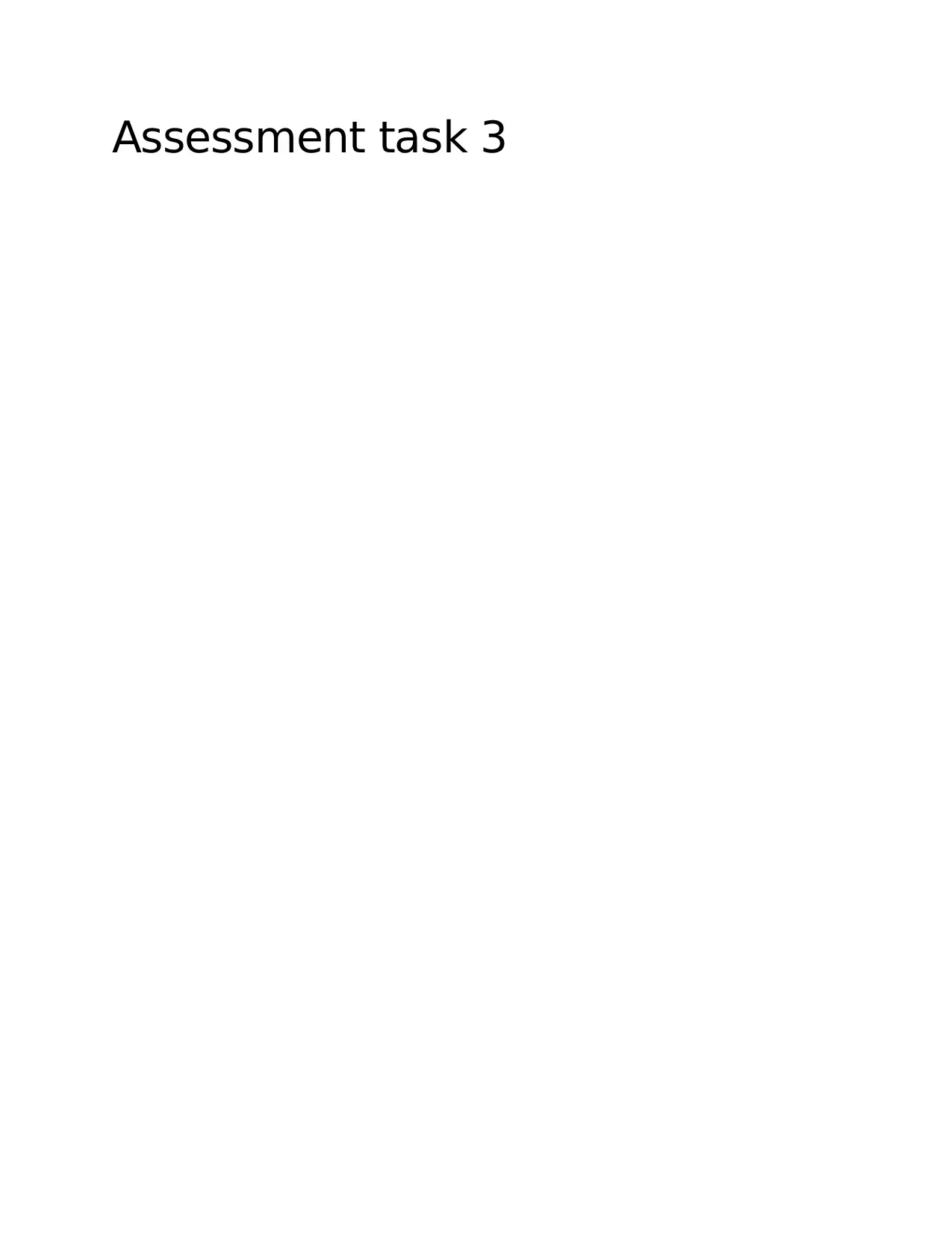
Assessment task 3
Paraphrase This Document
Need a fresh take? Get an instant paraphrase of this document with our AI Paraphraser
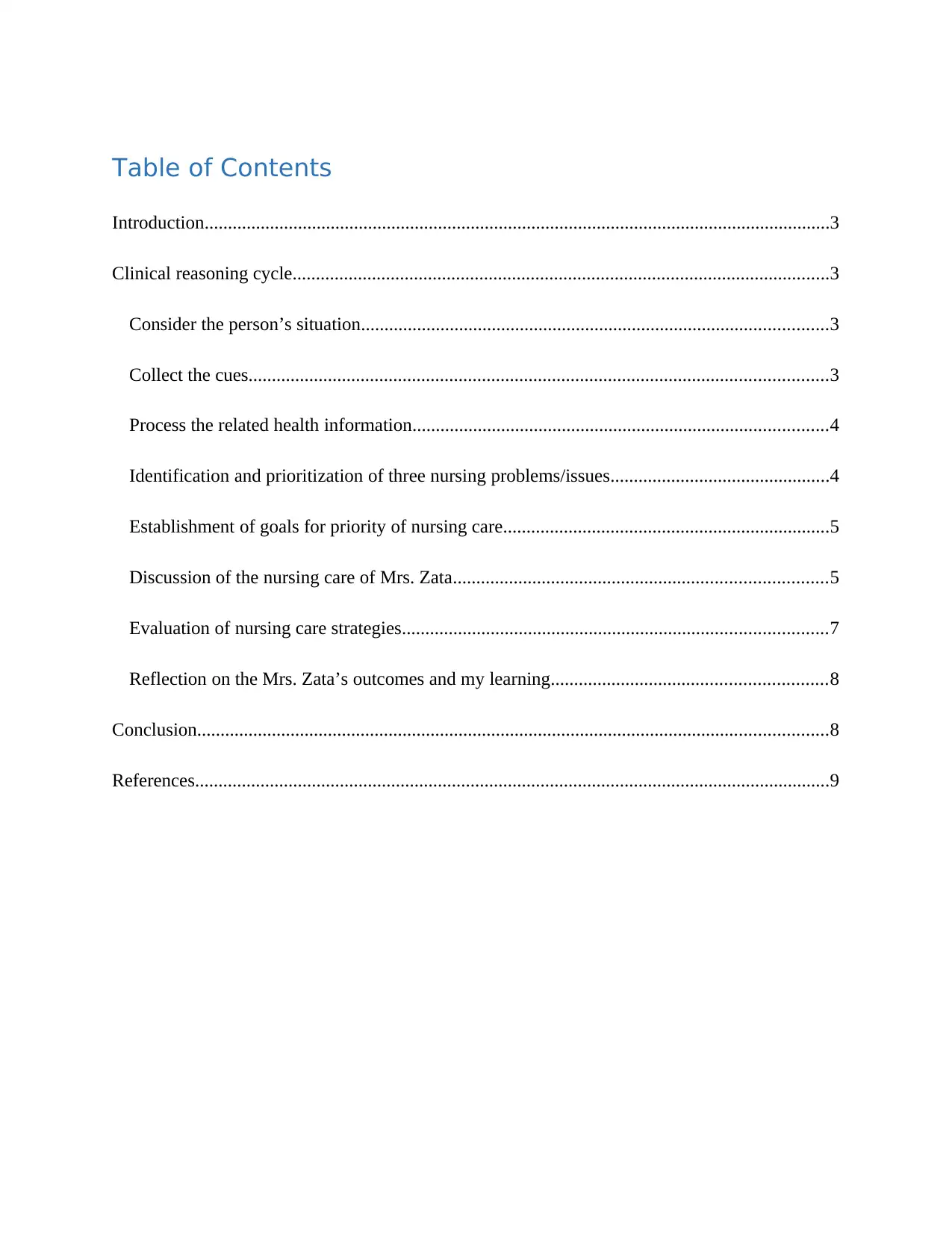
Table of Contents
Introduction......................................................................................................................................3
Clinical reasoning cycle...................................................................................................................3
Consider the person’s situation....................................................................................................3
Collect the cues............................................................................................................................3
Process the related health information.........................................................................................4
Identification and prioritization of three nursing problems/issues...............................................4
Establishment of goals for priority of nursing care......................................................................5
Discussion of the nursing care of Mrs. Zata................................................................................5
Evaluation of nursing care strategies...........................................................................................7
Reflection on the Mrs. Zata’s outcomes and my learning...........................................................8
Conclusion.......................................................................................................................................8
References........................................................................................................................................9
Introduction......................................................................................................................................3
Clinical reasoning cycle...................................................................................................................3
Consider the person’s situation....................................................................................................3
Collect the cues............................................................................................................................3
Process the related health information.........................................................................................4
Identification and prioritization of three nursing problems/issues...............................................4
Establishment of goals for priority of nursing care......................................................................5
Discussion of the nursing care of Mrs. Zata................................................................................5
Evaluation of nursing care strategies...........................................................................................7
Reflection on the Mrs. Zata’s outcomes and my learning...........................................................8
Conclusion.......................................................................................................................................8
References........................................................................................................................................9
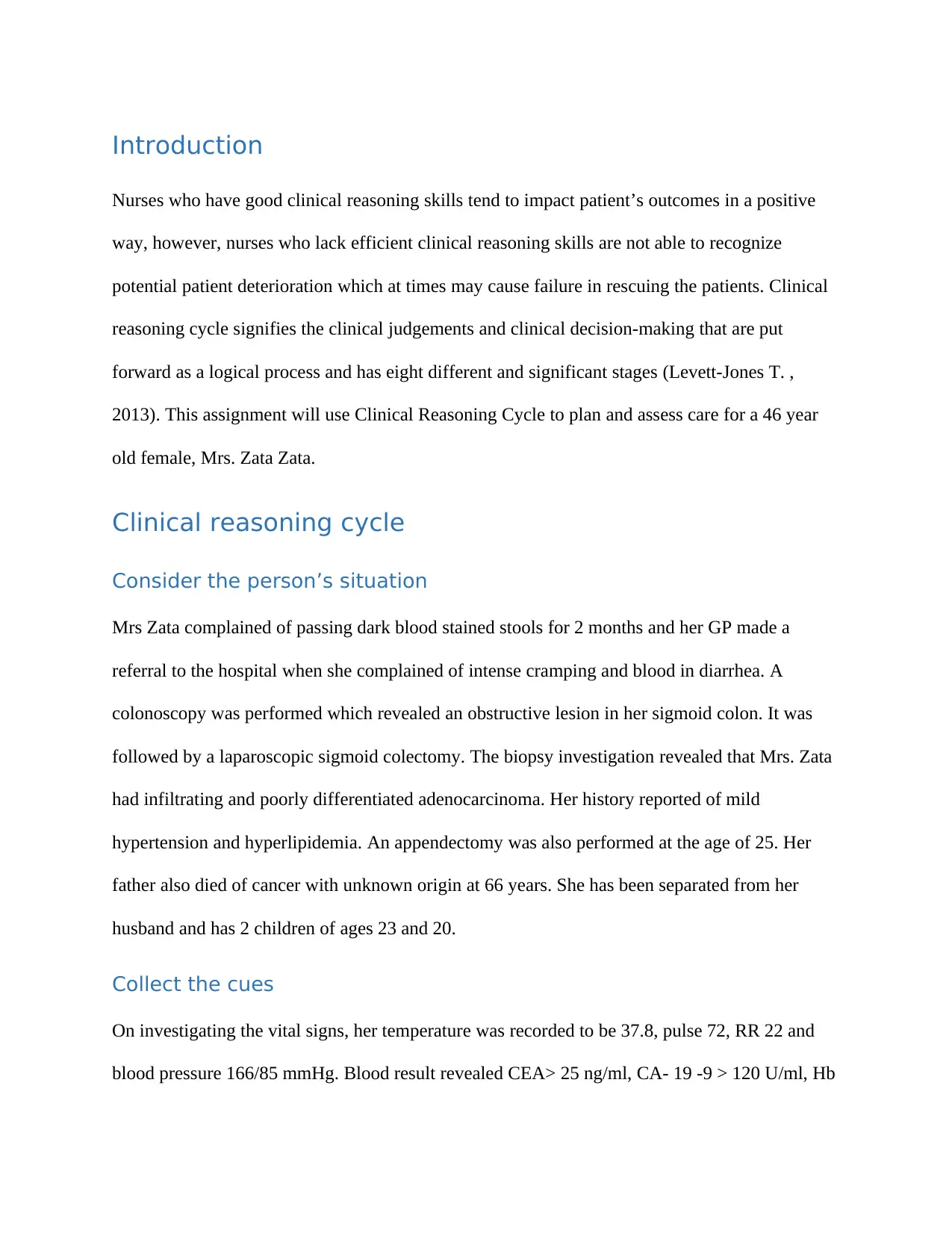
Introduction
Nurses who have good clinical reasoning skills tend to impact patient’s outcomes in a positive
way, however, nurses who lack efficient clinical reasoning skills are not able to recognize
potential patient deterioration which at times may cause failure in rescuing the patients. Clinical
reasoning cycle signifies the clinical judgements and clinical decision-making that are put
forward as a logical process and has eight different and significant stages (Levett-Jones T. ,
2013). This assignment will use Clinical Reasoning Cycle to plan and assess care for a 46 year
old female, Mrs. Zata Zata.
Clinical reasoning cycle
Consider the person’s situation
Mrs Zata complained of passing dark blood stained stools for 2 months and her GP made a
referral to the hospital when she complained of intense cramping and blood in diarrhea. A
colonoscopy was performed which revealed an obstructive lesion in her sigmoid colon. It was
followed by a laparoscopic sigmoid colectomy. The biopsy investigation revealed that Mrs. Zata
had infiltrating and poorly differentiated adenocarcinoma. Her history reported of mild
hypertension and hyperlipidemia. An appendectomy was also performed at the age of 25. Her
father also died of cancer with unknown origin at 66 years. She has been separated from her
husband and has 2 children of ages 23 and 20.
Collect the cues
On investigating the vital signs, her temperature was recorded to be 37.8, pulse 72, RR 22 and
blood pressure 166/85 mmHg. Blood result revealed CEA> 25 ng/ml, CA- 19 -9 > 120 U/ml, Hb
Nurses who have good clinical reasoning skills tend to impact patient’s outcomes in a positive
way, however, nurses who lack efficient clinical reasoning skills are not able to recognize
potential patient deterioration which at times may cause failure in rescuing the patients. Clinical
reasoning cycle signifies the clinical judgements and clinical decision-making that are put
forward as a logical process and has eight different and significant stages (Levett-Jones T. ,
2013). This assignment will use Clinical Reasoning Cycle to plan and assess care for a 46 year
old female, Mrs. Zata Zata.
Clinical reasoning cycle
Consider the person’s situation
Mrs Zata complained of passing dark blood stained stools for 2 months and her GP made a
referral to the hospital when she complained of intense cramping and blood in diarrhea. A
colonoscopy was performed which revealed an obstructive lesion in her sigmoid colon. It was
followed by a laparoscopic sigmoid colectomy. The biopsy investigation revealed that Mrs. Zata
had infiltrating and poorly differentiated adenocarcinoma. Her history reported of mild
hypertension and hyperlipidemia. An appendectomy was also performed at the age of 25. Her
father also died of cancer with unknown origin at 66 years. She has been separated from her
husband and has 2 children of ages 23 and 20.
Collect the cues
On investigating the vital signs, her temperature was recorded to be 37.8, pulse 72, RR 22 and
blood pressure 166/85 mmHg. Blood result revealed CEA> 25 ng/ml, CA- 19 -9 > 120 U/ml, Hb
⊘ This is a preview!⊘
Do you want full access?
Subscribe today to unlock all pages.

Trusted by 1+ million students worldwide

88 and Neutrophils <500/mcl. Currently she has been prescribed Rosuvastatin, Metoprolol,
Pantoprazole, Coloxyl and Senna, Targin and Endone. PRN medications included Panadol and
metoclopramide. She complained of intense pain with pain score of 8-10 at night. She also
experienced sleeplessness and constipation for four days. A weight reduction of 5kgs was also
observed in 14 days. Her hospital stay is extended by doctors for improvement of her
neutropenic state. Recently, Mrs Zata refused to get out of bed and eat.
Process the related health information
The pathological report along with blood results of Mrs. Zata confirmed that she has been
suffering from Sigmoid Adenocarcinoma Stage IV. Doctor ordered treatment of Mrs. Zata with
six cycles of chemotherapy to be followed by radiotherapy. Most of the colorectal polyps and
tumors are slow-growing which may have led to the delay by Mrs. Zata and the GP as they spent
time in determining whether their symptoms are of cancer. During this time the cancer cells grew
and invaded and destroyed the nearby normal tissue (Jensen, Hvidberg, Pedersen, & Vedsted,
2015).
Identification and prioritization of three nursing problems/issues
1. Acute pain- Mrs. Zata is suffering from intense pain which ranged between 8 and 10
particularly at night so, it becomes the priority of the nurse to minimise her pain so that
her suffering is reduced and she could sleep at night. The cause of the acute pain could be
her ongoing chemotherapy and radiotherapy as majority number of patients experience
pain in advance stage which is Mrs. Zata’s stage (Lu & Rosenthal, 2013)
Pantoprazole, Coloxyl and Senna, Targin and Endone. PRN medications included Panadol and
metoclopramide. She complained of intense pain with pain score of 8-10 at night. She also
experienced sleeplessness and constipation for four days. A weight reduction of 5kgs was also
observed in 14 days. Her hospital stay is extended by doctors for improvement of her
neutropenic state. Recently, Mrs Zata refused to get out of bed and eat.
Process the related health information
The pathological report along with blood results of Mrs. Zata confirmed that she has been
suffering from Sigmoid Adenocarcinoma Stage IV. Doctor ordered treatment of Mrs. Zata with
six cycles of chemotherapy to be followed by radiotherapy. Most of the colorectal polyps and
tumors are slow-growing which may have led to the delay by Mrs. Zata and the GP as they spent
time in determining whether their symptoms are of cancer. During this time the cancer cells grew
and invaded and destroyed the nearby normal tissue (Jensen, Hvidberg, Pedersen, & Vedsted,
2015).
Identification and prioritization of three nursing problems/issues
1. Acute pain- Mrs. Zata is suffering from intense pain which ranged between 8 and 10
particularly at night so, it becomes the priority of the nurse to minimise her pain so that
her suffering is reduced and she could sleep at night. The cause of the acute pain could be
her ongoing chemotherapy and radiotherapy as majority number of patients experience
pain in advance stage which is Mrs. Zata’s stage (Lu & Rosenthal, 2013)
Paraphrase This Document
Need a fresh take? Get an instant paraphrase of this document with our AI Paraphraser
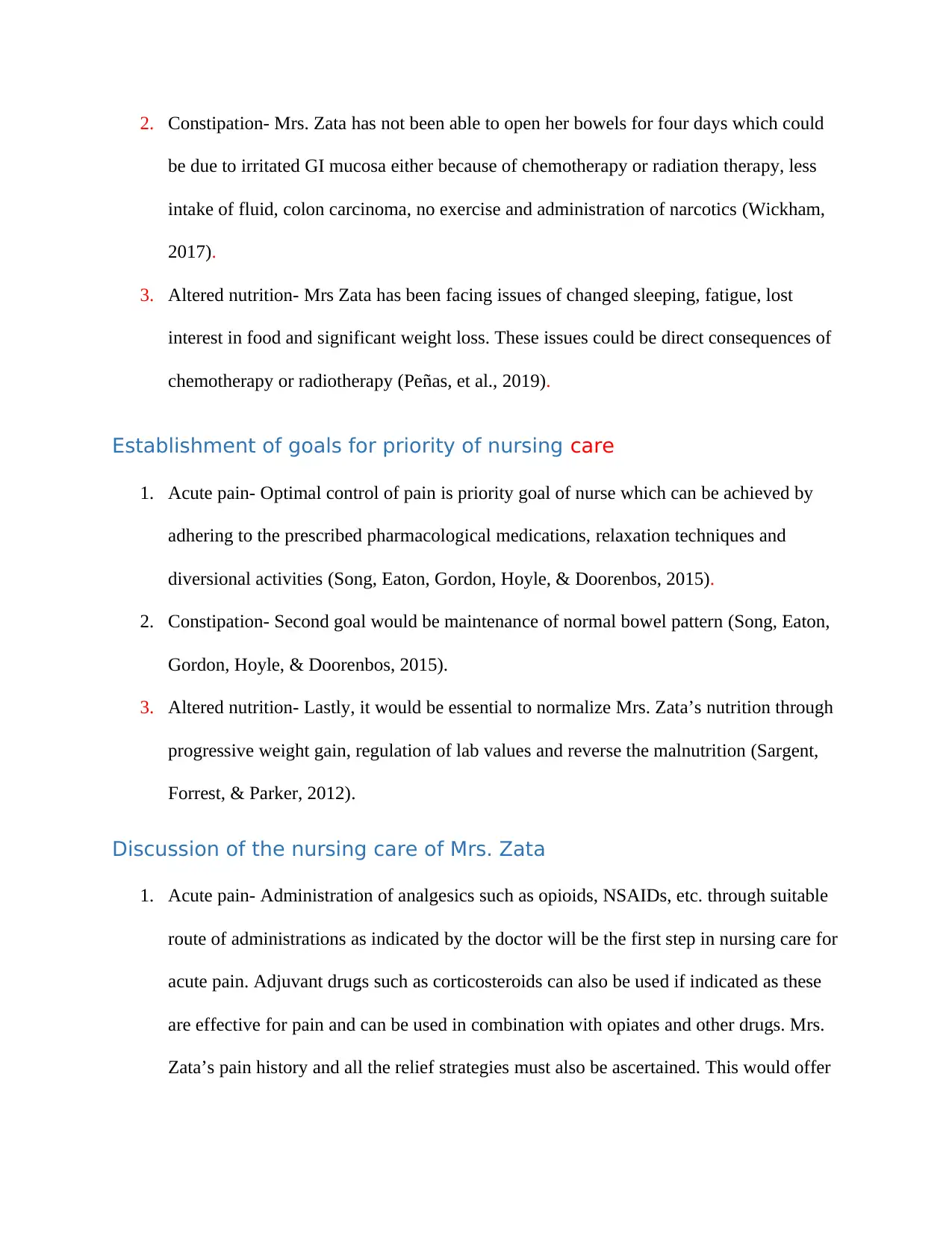
2. Constipation- Mrs. Zata has not been able to open her bowels for four days which could
be due to irritated GI mucosa either because of chemotherapy or radiation therapy, less
intake of fluid, colon carcinoma, no exercise and administration of narcotics (Wickham,
2017).
3. Altered nutrition- Mrs Zata has been facing issues of changed sleeping, fatigue, lost
interest in food and significant weight loss. These issues could be direct consequences of
chemotherapy or radiotherapy (Peñas, et al., 2019).
Establishment of goals for priority of nursing care
1. Acute pain- Optimal control of pain is priority goal of nurse which can be achieved by
adhering to the prescribed pharmacological medications, relaxation techniques and
diversional activities (Song, Eaton, Gordon, Hoyle, & Doorenbos, 2015).
2. Constipation- Second goal would be maintenance of normal bowel pattern (Song, Eaton,
Gordon, Hoyle, & Doorenbos, 2015).
3. Altered nutrition- Lastly, it would be essential to normalize Mrs. Zata’s nutrition through
progressive weight gain, regulation of lab values and reverse the malnutrition (Sargent,
Forrest, & Parker, 2012).
Discussion of the nursing care of Mrs. Zata
1. Acute pain- Administration of analgesics such as opioids, NSAIDs, etc. through suitable
route of administrations as indicated by the doctor will be the first step in nursing care for
acute pain. Adjuvant drugs such as corticosteroids can also be used if indicated as these
are effective for pain and can be used in combination with opiates and other drugs. Mrs.
Zata’s pain history and all the relief strategies must also be ascertained. This would offer
be due to irritated GI mucosa either because of chemotherapy or radiation therapy, less
intake of fluid, colon carcinoma, no exercise and administration of narcotics (Wickham,
2017).
3. Altered nutrition- Mrs Zata has been facing issues of changed sleeping, fatigue, lost
interest in food and significant weight loss. These issues could be direct consequences of
chemotherapy or radiotherapy (Peñas, et al., 2019).
Establishment of goals for priority of nursing care
1. Acute pain- Optimal control of pain is priority goal of nurse which can be achieved by
adhering to the prescribed pharmacological medications, relaxation techniques and
diversional activities (Song, Eaton, Gordon, Hoyle, & Doorenbos, 2015).
2. Constipation- Second goal would be maintenance of normal bowel pattern (Song, Eaton,
Gordon, Hoyle, & Doorenbos, 2015).
3. Altered nutrition- Lastly, it would be essential to normalize Mrs. Zata’s nutrition through
progressive weight gain, regulation of lab values and reverse the malnutrition (Sargent,
Forrest, & Parker, 2012).
Discussion of the nursing care of Mrs. Zata
1. Acute pain- Administration of analgesics such as opioids, NSAIDs, etc. through suitable
route of administrations as indicated by the doctor will be the first step in nursing care for
acute pain. Adjuvant drugs such as corticosteroids can also be used if indicated as these
are effective for pain and can be used in combination with opiates and other drugs. Mrs.
Zata’s pain history and all the relief strategies must also be ascertained. This would offer

the reference data to assess the usefulness of the interventions. Nurse must also ascertain
time and or threshold of breakthrough pain while utilising around-the-clock agents. If
Mrs. Zata complains of pain near the end of the dose interval, it would indicate the
requirement of increased dose or shorter interval of dose. In addition, the precipitators of
pain could be identifiable or random triggers which will indicate the use of short half-life
drugs for rescue or supplement therapy. The painful impact of specific interventions Mrs.
Zata is going through which is radiation, chemotherapy must also be assessed. Nurse
must share the information to Mrs. Zata and her family regarding what to expect. It will
help have realistic expectations in her own skills to manage what happens.
Nonpharmacological comfort strategies such as massage, repositioning, diversional
activities such as music can also be implemented in nursing care. Comfort and
diversional activities may encourage relaxation and help Mrs. Zata in refocusing attention
(Tajerian & Clark, 2017). Likewise, stress management techniques and complementary
therapies such as guided imagery, aromatherapy, and therapeutic touch can also be used.
These techniques will facilitate Mrs. Zata in engaging in non-pharmaceutical
management of pain actively and increase sense of control. Pain generates stress which
along with muscle tension and intrinsic stressors, so it may enhance Mrs. Zata’s focus on
herself, which in turn elevates the pain level. Cutaneous stimulation can also be given as
it can lower inflammation, muscle spasms, thereby reducing associated pain.
2. Constipation- Normal elimination habits must be determined as this information would
be baseline to evaluate the therapeutic requirements and usefulness. Examination of the
bowel sounds and bowel movements for frequency, consistency is also significant as it
will help in defining the issue as constipation is one of the first indicators of neurotoxicity
time and or threshold of breakthrough pain while utilising around-the-clock agents. If
Mrs. Zata complains of pain near the end of the dose interval, it would indicate the
requirement of increased dose or shorter interval of dose. In addition, the precipitators of
pain could be identifiable or random triggers which will indicate the use of short half-life
drugs for rescue or supplement therapy. The painful impact of specific interventions Mrs.
Zata is going through which is radiation, chemotherapy must also be assessed. Nurse
must share the information to Mrs. Zata and her family regarding what to expect. It will
help have realistic expectations in her own skills to manage what happens.
Nonpharmacological comfort strategies such as massage, repositioning, diversional
activities such as music can also be implemented in nursing care. Comfort and
diversional activities may encourage relaxation and help Mrs. Zata in refocusing attention
(Tajerian & Clark, 2017). Likewise, stress management techniques and complementary
therapies such as guided imagery, aromatherapy, and therapeutic touch can also be used.
These techniques will facilitate Mrs. Zata in engaging in non-pharmaceutical
management of pain actively and increase sense of control. Pain generates stress which
along with muscle tension and intrinsic stressors, so it may enhance Mrs. Zata’s focus on
herself, which in turn elevates the pain level. Cutaneous stimulation can also be given as
it can lower inflammation, muscle spasms, thereby reducing associated pain.
2. Constipation- Normal elimination habits must be determined as this information would
be baseline to evaluate the therapeutic requirements and usefulness. Examination of the
bowel sounds and bowel movements for frequency, consistency is also significant as it
will help in defining the issue as constipation is one of the first indicators of neurotoxicity
⊘ This is a preview!⊘
Do you want full access?
Subscribe today to unlock all pages.

Trusted by 1+ million students worldwide
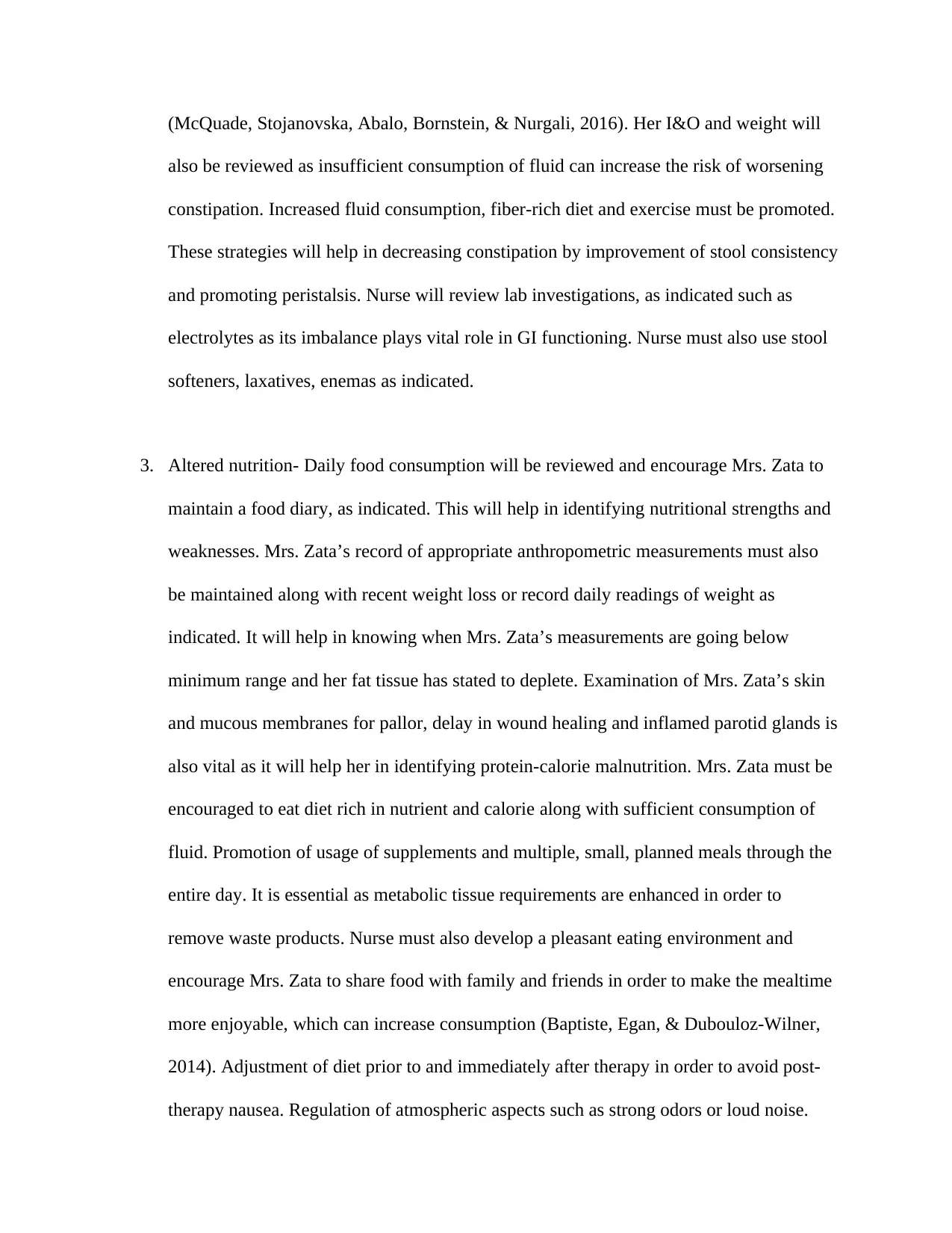
(McQuade, Stojanovska, Abalo, Bornstein, & Nurgali, 2016). Her I&O and weight will
also be reviewed as insufficient consumption of fluid can increase the risk of worsening
constipation. Increased fluid consumption, fiber-rich diet and exercise must be promoted.
These strategies will help in decreasing constipation by improvement of stool consistency
and promoting peristalsis. Nurse will review lab investigations, as indicated such as
electrolytes as its imbalance plays vital role in GI functioning. Nurse must also use stool
softeners, laxatives, enemas as indicated.
3. Altered nutrition- Daily food consumption will be reviewed and encourage Mrs. Zata to
maintain a food diary, as indicated. This will help in identifying nutritional strengths and
weaknesses. Mrs. Zata’s record of appropriate anthropometric measurements must also
be maintained along with recent weight loss or record daily readings of weight as
indicated. It will help in knowing when Mrs. Zata’s measurements are going below
minimum range and her fat tissue has stated to deplete. Examination of Mrs. Zata’s skin
and mucous membranes for pallor, delay in wound healing and inflamed parotid glands is
also vital as it will help her in identifying protein-calorie malnutrition. Mrs. Zata must be
encouraged to eat diet rich in nutrient and calorie along with sufficient consumption of
fluid. Promotion of usage of supplements and multiple, small, planned meals through the
entire day. It is essential as metabolic tissue requirements are enhanced in order to
remove waste products. Nurse must also develop a pleasant eating environment and
encourage Mrs. Zata to share food with family and friends in order to make the mealtime
more enjoyable, which can increase consumption (Baptiste, Egan, & Dubouloz-Wilner,
2014). Adjustment of diet prior to and immediately after therapy in order to avoid post-
therapy nausea. Regulation of atmospheric aspects such as strong odors or loud noise.
also be reviewed as insufficient consumption of fluid can increase the risk of worsening
constipation. Increased fluid consumption, fiber-rich diet and exercise must be promoted.
These strategies will help in decreasing constipation by improvement of stool consistency
and promoting peristalsis. Nurse will review lab investigations, as indicated such as
electrolytes as its imbalance plays vital role in GI functioning. Nurse must also use stool
softeners, laxatives, enemas as indicated.
3. Altered nutrition- Daily food consumption will be reviewed and encourage Mrs. Zata to
maintain a food diary, as indicated. This will help in identifying nutritional strengths and
weaknesses. Mrs. Zata’s record of appropriate anthropometric measurements must also
be maintained along with recent weight loss or record daily readings of weight as
indicated. It will help in knowing when Mrs. Zata’s measurements are going below
minimum range and her fat tissue has stated to deplete. Examination of Mrs. Zata’s skin
and mucous membranes for pallor, delay in wound healing and inflamed parotid glands is
also vital as it will help her in identifying protein-calorie malnutrition. Mrs. Zata must be
encouraged to eat diet rich in nutrient and calorie along with sufficient consumption of
fluid. Promotion of usage of supplements and multiple, small, planned meals through the
entire day. It is essential as metabolic tissue requirements are enhanced in order to
remove waste products. Nurse must also develop a pleasant eating environment and
encourage Mrs. Zata to share food with family and friends in order to make the mealtime
more enjoyable, which can increase consumption (Baptiste, Egan, & Dubouloz-Wilner,
2014). Adjustment of diet prior to and immediately after therapy in order to avoid post-
therapy nausea. Regulation of atmospheric aspects such as strong odors or loud noise.
Paraphrase This Document
Need a fresh take? Get an instant paraphrase of this document with our AI Paraphraser
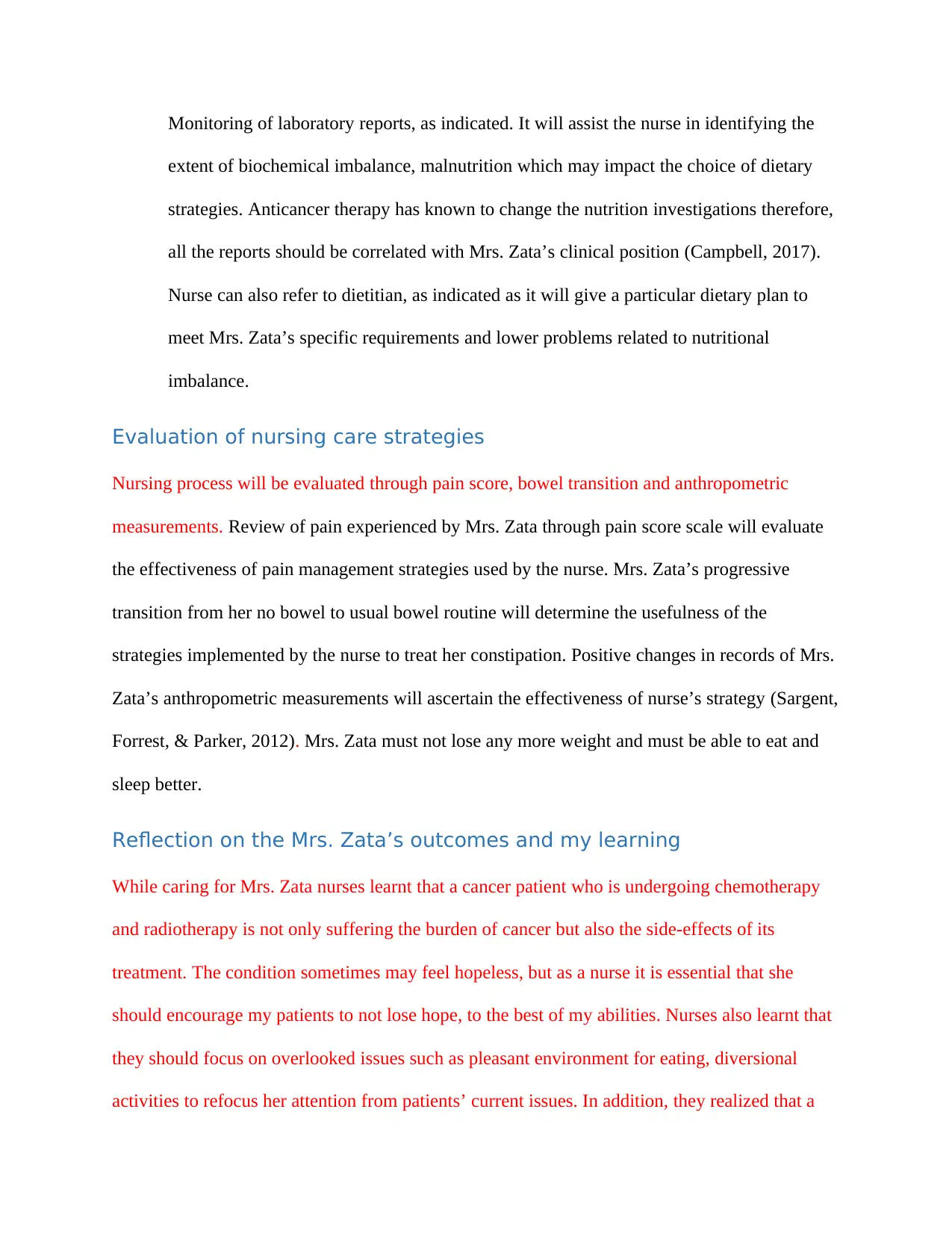
Monitoring of laboratory reports, as indicated. It will assist the nurse in identifying the
extent of biochemical imbalance, malnutrition which may impact the choice of dietary
strategies. Anticancer therapy has known to change the nutrition investigations therefore,
all the reports should be correlated with Mrs. Zata’s clinical position (Campbell, 2017).
Nurse can also refer to dietitian, as indicated as it will give a particular dietary plan to
meet Mrs. Zata’s specific requirements and lower problems related to nutritional
imbalance.
Evaluation of nursing care strategies
Nursing process will be evaluated through pain score, bowel transition and anthropometric
measurements. Review of pain experienced by Mrs. Zata through pain score scale will evaluate
the effectiveness of pain management strategies used by the nurse. Mrs. Zata’s progressive
transition from her no bowel to usual bowel routine will determine the usefulness of the
strategies implemented by the nurse to treat her constipation. Positive changes in records of Mrs.
Zata’s anthropometric measurements will ascertain the effectiveness of nurse’s strategy (Sargent,
Forrest, & Parker, 2012). Mrs. Zata must not lose any more weight and must be able to eat and
sleep better.
Reflection on the Mrs. Zata’s outcomes and my learning
While caring for Mrs. Zata nurses learnt that a cancer patient who is undergoing chemotherapy
and radiotherapy is not only suffering the burden of cancer but also the side-effects of its
treatment. The condition sometimes may feel hopeless, but as a nurse it is essential that she
should encourage my patients to not lose hope, to the best of my abilities. Nurses also learnt that
they should focus on overlooked issues such as pleasant environment for eating, diversional
activities to refocus her attention from patients’ current issues. In addition, they realized that a
extent of biochemical imbalance, malnutrition which may impact the choice of dietary
strategies. Anticancer therapy has known to change the nutrition investigations therefore,
all the reports should be correlated with Mrs. Zata’s clinical position (Campbell, 2017).
Nurse can also refer to dietitian, as indicated as it will give a particular dietary plan to
meet Mrs. Zata’s specific requirements and lower problems related to nutritional
imbalance.
Evaluation of nursing care strategies
Nursing process will be evaluated through pain score, bowel transition and anthropometric
measurements. Review of pain experienced by Mrs. Zata through pain score scale will evaluate
the effectiveness of pain management strategies used by the nurse. Mrs. Zata’s progressive
transition from her no bowel to usual bowel routine will determine the usefulness of the
strategies implemented by the nurse to treat her constipation. Positive changes in records of Mrs.
Zata’s anthropometric measurements will ascertain the effectiveness of nurse’s strategy (Sargent,
Forrest, & Parker, 2012). Mrs. Zata must not lose any more weight and must be able to eat and
sleep better.
Reflection on the Mrs. Zata’s outcomes and my learning
While caring for Mrs. Zata nurses learnt that a cancer patient who is undergoing chemotherapy
and radiotherapy is not only suffering the burden of cancer but also the side-effects of its
treatment. The condition sometimes may feel hopeless, but as a nurse it is essential that she
should encourage my patients to not lose hope, to the best of my abilities. Nurses also learnt that
they should focus on overlooked issues such as pleasant environment for eating, diversional
activities to refocus her attention from patients’ current issues. In addition, they realized that a

cancer patient needs a holistic and person-centered treatment as each case is different yet all
cases suffer physically as well as mentally (Nandini, Sridhar, Usharani, Kumar, & Salins, 2011).
Conclusion
Levitt-Jones clinical reasoning cycle is a logical tool that can assist the health professionals at
each step of care delivery. Nurse was able to make decisions of her capacity and follow
instructions efficiently by using clinical reasoning cycle in Mrs. Zata’s case and meet her care
needs. Nurse can also identifying and prioritize the nursing problems like in Mrs. Zata’s case by
using the cycle. It also assisted in care planning, specifying the goals of nursing care, evaluating
the consequences of nurse’s action and finally reflect on the case. Therefore, it can be concluded
that implementation of the cycle, lowers the chances of error during care delivery. Instead, usage
of the clinical reasoning cycle makes the nursing practice more organized and holistic.
References
Baptiste, F., Egan, M., & Dubouloz-Wilner, C.-J. (2014). Geriatric Rehabilitation Patients’
Perceptions of Unit Dining Locations. Can Geriatr J, 17(2), 38-44. doi:10.5770/cgj.17.54
Campbell, T. C. (2017). Cancer Prevention and Treatment by Wholistic Nutrition. J Nat Sci.,
3(10).
Jensen, L. F., Hvidberg, L., Pedersen, A. F., & Vedsted, P. (2015). Symptom attributions in
patients with colorectal cancer. BMC Fam Pract. doi:10.1186/s12875-015-0315-9
Levett-Jones, T. (2013). Clinical reasoning: Learning to think like a nurse. Pearson Australia.
Levett-Jones, T., Hoffman, K., Dempsey, J., Jeong, S. Y.-S., & Noble, D. (2010). The ‘five
rights’ of clinical reasoning: An educational model to enhance nursing students’ ability to
cases suffer physically as well as mentally (Nandini, Sridhar, Usharani, Kumar, & Salins, 2011).
Conclusion
Levitt-Jones clinical reasoning cycle is a logical tool that can assist the health professionals at
each step of care delivery. Nurse was able to make decisions of her capacity and follow
instructions efficiently by using clinical reasoning cycle in Mrs. Zata’s case and meet her care
needs. Nurse can also identifying and prioritize the nursing problems like in Mrs. Zata’s case by
using the cycle. It also assisted in care planning, specifying the goals of nursing care, evaluating
the consequences of nurse’s action and finally reflect on the case. Therefore, it can be concluded
that implementation of the cycle, lowers the chances of error during care delivery. Instead, usage
of the clinical reasoning cycle makes the nursing practice more organized and holistic.
References
Baptiste, F., Egan, M., & Dubouloz-Wilner, C.-J. (2014). Geriatric Rehabilitation Patients’
Perceptions of Unit Dining Locations. Can Geriatr J, 17(2), 38-44. doi:10.5770/cgj.17.54
Campbell, T. C. (2017). Cancer Prevention and Treatment by Wholistic Nutrition. J Nat Sci.,
3(10).
Jensen, L. F., Hvidberg, L., Pedersen, A. F., & Vedsted, P. (2015). Symptom attributions in
patients with colorectal cancer. BMC Fam Pract. doi:10.1186/s12875-015-0315-9
Levett-Jones, T. (2013). Clinical reasoning: Learning to think like a nurse. Pearson Australia.
Levett-Jones, T., Hoffman, K., Dempsey, J., Jeong, S. Y.-S., & Noble, D. (2010). The ‘five
rights’ of clinical reasoning: An educational model to enhance nursing students’ ability to
⊘ This is a preview!⊘
Do you want full access?
Subscribe today to unlock all pages.

Trusted by 1+ million students worldwide

identify and manage clinically ‘at risk’ patients. Nurse Education Today, 30, 515–520.
doi:10.1016/j.nedt.2009.10.020
Lu, W., & Rosenthal, D. S. (2013). Acupuncture for Cancer Pain and Related Symptoms. Curr
Pain Headache Rep, 17(3). doi:10.1007/s11916-013-0321-3
McQuade, R. M., Stojanovska, V., Abalo, R., Bornstein, J. C., & Nurgali, K. (2016).
Chemotherapy-Induced Constipation and Diarrhea: Pathophysiology, Current and
Emerging Treatments. Front Pharmacol. doi:10.3389/fphar.2016.00414
Nandini, V., Sridhar, C., Usharani, M., Kumar, J. P., & Salins, N. (2011). Incorporating Person
Centred Care Principles into an Ongoing Comprehensive Cancer Management Program:
An Experiential Account. Indian J Palliat Care, 17, S61-S67. doi:10.4103/0973-
1075.76245
Peñas, R. d., Majem, M., Perez-Altozano, J., Virizuela, J. A., Cancer, E., Diz, P., . . . Ocon, M. J.
(2019). SEOM clinical guidelines on nutrition in cancer patients (2018). Clin Transl
Oncol, 21(1), 87-93. doi:10.1007/s12094-018-02009-3
Sargent, G. M., Forrest, L. E., & Parker, R. M. (2012). Nurse delivered lifestyle interventions in
primary health care to treat chronic disease risk factors associated with obesity: a
systematic review. Obes Rev., 13(12), 1148-71. doi:10.1111/j.1467-789X.2012.01029.x
Song, W., Eaton, L. H., Gordon, D. B., Hoyle, C., & Doorenbos, A. Z. (2015). Evaluation of
Evidence-Based Nursing Pain Management Practice. Pain Manag Nurs, 16(4), 456-63.
doi:10.1016/j.pmn.2014.09.001
doi:10.1016/j.nedt.2009.10.020
Lu, W., & Rosenthal, D. S. (2013). Acupuncture for Cancer Pain and Related Symptoms. Curr
Pain Headache Rep, 17(3). doi:10.1007/s11916-013-0321-3
McQuade, R. M., Stojanovska, V., Abalo, R., Bornstein, J. C., & Nurgali, K. (2016).
Chemotherapy-Induced Constipation and Diarrhea: Pathophysiology, Current and
Emerging Treatments. Front Pharmacol. doi:10.3389/fphar.2016.00414
Nandini, V., Sridhar, C., Usharani, M., Kumar, J. P., & Salins, N. (2011). Incorporating Person
Centred Care Principles into an Ongoing Comprehensive Cancer Management Program:
An Experiential Account. Indian J Palliat Care, 17, S61-S67. doi:10.4103/0973-
1075.76245
Peñas, R. d., Majem, M., Perez-Altozano, J., Virizuela, J. A., Cancer, E., Diz, P., . . . Ocon, M. J.
(2019). SEOM clinical guidelines on nutrition in cancer patients (2018). Clin Transl
Oncol, 21(1), 87-93. doi:10.1007/s12094-018-02009-3
Sargent, G. M., Forrest, L. E., & Parker, R. M. (2012). Nurse delivered lifestyle interventions in
primary health care to treat chronic disease risk factors associated with obesity: a
systematic review. Obes Rev., 13(12), 1148-71. doi:10.1111/j.1467-789X.2012.01029.x
Song, W., Eaton, L. H., Gordon, D. B., Hoyle, C., & Doorenbos, A. Z. (2015). Evaluation of
Evidence-Based Nursing Pain Management Practice. Pain Manag Nurs, 16(4), 456-63.
doi:10.1016/j.pmn.2014.09.001
Paraphrase This Document
Need a fresh take? Get an instant paraphrase of this document with our AI Paraphraser

Tajerian, M., & Clark, J. D. (2017). Nonpharmacological Interventions in Targeting Pain-Related
Brain Plasticity. Neural Plast. doi:10.1155/2017/2038573
Wickham, R. J. (2017). Managing Constipation in Adults With Cancer. J Adv Pract Oncol., 8(2),
149-61.
Brain Plasticity. Neural Plast. doi:10.1155/2017/2038573
Wickham, R. J. (2017). Managing Constipation in Adults With Cancer. J Adv Pract Oncol., 8(2),
149-61.
1 out of 11
Related Documents
Your All-in-One AI-Powered Toolkit for Academic Success.
+13062052269
info@desklib.com
Available 24*7 on WhatsApp / Email
![[object Object]](/_next/static/media/star-bottom.7253800d.svg)
Unlock your academic potential
Copyright © 2020–2025 A2Z Services. All Rights Reserved. Developed and managed by ZUCOL.





